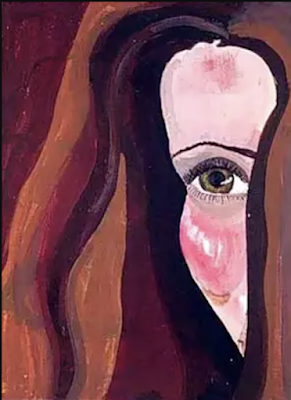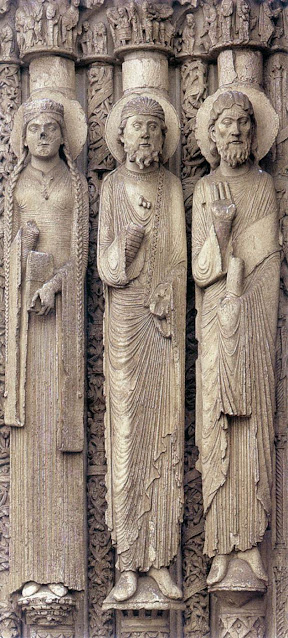Most people would agree that the work on the left is “bad” and the work on the right is “good” but WHY?
Left: Dawn Marie Jingagian, Shy Glance, 1976, acrylic on canvas, from The Museum of Bad Art
Right: Elizabeth Vigee-Lebrun, Self-Portrait in a Straw Hat, 1782, oil on canvas, The National Gallery, London
Shy Glance displays a blotchy, streaky application of paint, strange proportions, and a confusing depiction of space.
Self-Portrait in a Straw Hat displays a balance of pastel warm and cool colors, illusionistic portrayal of textures, and convincing space and proportions.
It is clear that Self-Portrait in a Straw Hat was painted with greater technical skill than Shy Glance. It demonstrates mastery of the technique and can therefore be described as a better painting.
However, some people might find Self-Portrait in a Straw Hat rather boring. It’s a three-quarters view portrait of a pretty woman from the past in pretty clothes in front of a pretty sky. We’ve probably seen images like this before.
Shy Glance, on the other hand, perhaps offers us a more unique image. It has charm in its naivety.
Both views are valid.
Technical skill is one criteria for judging art but it is by no means the only one.
Let’s consider these two works:
Spear Bearer, Greek, and figures from the west portal of Chartres Cathedral, Medieval
The Greeks valued the ideal state of nature and the human body, and their art was judged by how beautifully they depicted those two things.
However, Christians during the Middle Ages valued art that glorified God and the Church and adhered to artistic traditions. Realism was not a criteria used for judging art. They judged art by its symbolic properties.
How we evaluate an artwork depends on what criteria we are using or find important. The type of artwork that we prefer reveals a great deal about who we are.
For example, I love minimalist art, both painting and sculpture. I find the limited colors and minimal visual stimulation calming and soothing. I value those peaceful moments in my otherwise chaotic life. You perhaps have other aspects you value in art.
ART CRITICISM is the process of using formal analysis, description, and interpretation to evaluate or explain the quality and meanings of art.
Also, art criticism is making discriminating judgments, both favorable and unfavorable. Criticism contains both the good and the bad.
We can classify most theories or criteria for evaluating art into three categories:
Formal theories focus attention on the composition of the works and how it may have been influenced by earlier works – EMPHASIZES THE WORK
Contextual theories consider art as a product of a particular culture and value system – EMPHASIZES THE CULTURE
Expressive theories pay attention to the artist’s expression of a personality or world-view – EMPHASIZES THE ARTIST
Let’s take one painting and discuss it based on each of these three theories.
Titian, Pietà, 1575-1576, oil on canvas
Formally, we’re going to look at its composition, colors, technique – all the stuff we can see.
One interesting formal aspect of this painting is its composition. In many Renaissance paintings, the main subject of the painting is placed in the center. The center of this painting, however, is an empty space within a niche. That is extremely uncommon for paintings of this time, so it is a unique and innovative aspect of this painting.
Contextually, we’ll consider the painting’s history and background.
This piece was created for a chapel in a church. It’s a religious scene, so that seems fitting. It was also created during a time of plague. The scene depicted is a pieta (dead Christ draped over the lap of his mother). Mary and the man on the right are saddened by the death of Christ. This would have been a relatable scene to individuals who were also experiencing deaths of loved ones and served as a comforting reminder to the local people that death is natural and there is hope in what lies beyond.
Expressively, we will consider the painting as a work created by an individual – Titian.
Titian created this painting in the last year of his life. Titian is, in fact, the man in red at the lower right. We can interpret this painting as an act of faith by Titian, showing his faith to Christ when he knows that his days on earth are numbered.
Now let’s revisit Self-Portrait in a Straw Hat.
I actually really enjoy this painting, mostly due to its context.
The work was painted by Elizabeth Vigee-Lebrun, who was the court painter to Marie Antoinette. A female court painter was extremely rare at this time, and Vigee-Lebrun lived quite an independent, colorful life. She was famous for her extravagant parties and scandalous stories surrounded her separation from her husband. For these reasons, I find this painting especially appealing.
In conclusion, for a work of art to be considered “great,” it succeeds when viewed according to each of these three theories: the work displays some degree of innovation, important cultural meanings, and a recognizable personal statement.
Now if a work actually possesses these things or not can always be a matter of debate.






